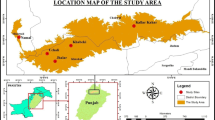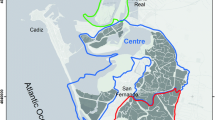Abstract
Wetlands, like any other ecosystem, have important characteristics (hydrology, soil, vegetation) that distinguish them from other ecosystems and allow them to provide vital habitats for insects, fish, birds, and other wildlife. Wetlands in the Wilaya of Oran, Algeria, include the Great Sebkha, the marshes of Macta, Lake Telamine, and the salt pans of Arzew, all known for their rich diversity of fauna and flora, are known worldwide for their ecological importance. The objective of this work is to develop an operational geomatic approach for the delineation, evaluation and use of information on North African wetlands. The Digital Atlas made it possible to highlight another aspect of this significant diversity of wetlands in western Algeria, through a new technique for presenting the results used in a web mapping. In the context of global changes driving a steep erosion of biodiversity, this study shows the importance of wetlands in western Algeria and allows citizens to learn about the richness, beauty and extent of their natural heritage. It contributes to public awareness and provides a valuable assessment and evaluation tool available to decision makers and professionals in the field of nature management and conservation. The findings of this study demonstrate, among other things, that considerable scientific advances of a practical kind may be made in the field of remote sensing. These can potentially be linked to managers' needs for tools to inventory and delineate wetlands and to monitor wetland development and conservation status. The Digital Atlas made it possible to discover another aspect of the consequent diversity of North African wetlands, through a new technique of presenting results in the context of web mapping.












Similar content being viewed by others
Data availability
The data sets for this study are not available.
References
Acreman MC, McCartney MP (2009) 28 Hydrological Impacts in and around Wetlands. Wetl Handb 643
Aouadi A, Samraoui F, Touati L, Nedjah R, Souiki L, Samraoui B (2021) Close to the Madding Crowd: Waterbird Responses to Land Use Conversion in and Around a Mediterranean Urban Wetland. Wetlands 41:1–12
Barnaud G, Dausse A (2000) Vers une standardisation des méthodes d’identification de détermination, de délimitation des zones humides. ZH Infos 29
Benslimane N, Chakri K, Haiahem D, Guelmami A, Samraoui F, Samraoui B (2019) Anthropogenic stressors are driving a steep decline of hemipteran diversity in dune ponds in north-eastern Algeria. J Insect Conserv 23:475–488
Betbeder J (2015) Evaluation des données de télédétection pour l’identification et la caractérisation des continuités écologiques (PhD Thesis). Université Rennes 2
Boix D, Sala J, Gascon S, Martinoy M, Gifre J, Brucet S, Badosa A, López-Flores R, Quintana XD (2007) Comparative biodiversity of crustaceans and aquatic insects from various water body types in coastal Mediterranean wetlands, in: Shallow Lakes in a Changing World: Proceedings of the 5th International Symposium on Shallow Lakes, Held at Dalfsen, The Netherlands, 5–9 June 2005. Springer, pp. 347–359
Bullock A, Acreman M (2003) The role of wetlands in the hydrological cycle
Clément B, Hubert-Moy L, Rapinel S (2008) Evaluation des fonctions des zones humides à partir de données de télédétection à très haute résolution spatiale. Appl. Expérimentale À Basse Val. Dordogne Rapp. COS℡ UMR 6554, 92
Corbane C, Lang S, Pipkins K, Alleaume S, Deshayes M, Millán VEG, Strasser T, Borre JV, Toon S, Michael F (2015) Remote sensing for mapping natural habitats and their conservation status–New opportunities and challenges. Int J Appl Earth Obs Geoinformation 37:7–16
Demnati F, Samraoui B, Allache F, Sandoz A, Ernoul L (2017) A literature review of Algerian salt lakes: values, threats and implications. Environ Earth Sci 76:1–15
D.G.F (2016) Recensement hivernal international d’oiseaux d’eau région nord ouest Algérien année 2016
D.G.F (2004) Atlas des zones humides Algériennes d’importance internationale. Ministère Agriculture Développement Rural, 75 p
Dusseux P, Hubert-Moy L, Corpetti T, Vertès F (2015) Evaluation of SPOT imagery for the estimation of grassland biomass. Int J Appl Earth Obs Geoinformation 38:72–77
Fustec É, Lefeuvre J-C (2000) Fonctions et valeurs des zones humides. Dunod
Gao B-C (1995) Normalized difference water index for remote sensing of vegetation liquid water from space, in: Imaging Spectrometry. SPIE, pp. 225–236
Gourinard Y (1952) Le littoral oranais (mouvements verticaux et anomalies gravimétriques). 19e Congrès géologique international, Alger, 1952. Monogr Région1re Sér 22, 62
Hettiarachchi M, Morrison T, McAlpine C (2015) Forty-three years of Ramsar and urban wetlands. Glob Environ Change 32:57–66
Hubert-Moy L, Clément B, Lennon M, Houet T, Lefeuvre E (2003) Etude de zones humides de fond de vallées à partir d’images hyperspectrales CASI: Application à un bassin versant de la région de Pleine-Fougères (Bretagne, France). Photo-Interprétation Eur J Appl Remote Sens 39:33–43
Hubert-Moy, L., Michel, K., Corpetti, T., Clément, B., 2006. Object-oriented mapping and analysis of wetlands using SPOT 5 data. IEEE, pp. 3447–3450.
Janssen R, Goosen H, Verhoeven ML, Verhoeven JT, Omtzigt A, Maltby E (2005) Decision support for integrated wetland management. Environ Model Softw 20:215–229
Mahdavi S, Salehi B, Granger J, Amani M, Brisco B, Huang W (2018) Remote sensing for wetland classification: A comprehensive review. Giscience Remote Sens 55:623–658
Maltby E, Acreman MC (2011) Ecosystem services of wetlands: pathfinder for a new paradigm. Hydrol Sci J 56:1341–1359
Maltby E, Barker T (2009) The Wetlands Handbook, 2, vol Set. John Wiley & Sons
Médail F, Quézel P (1999) Biodiversity hotspots in the Mediterranean Basin: setting global conservation priorities. Conserv Biol 13:1510–1513
Meinel G, Neubert M (2004) A comparison of segmentation programs for high resolution remote sensing data. Int Arch Photogramm Remote Sens 35:1097–1105
Mérot P, Gascuel C, Durand P (2005) Typologie fonctionnelle: application aux petites zones humides de fond de vallée. Caractér. Zones Humides Cah. Thématique PNRZH MEDD Agences L’eau BRGM 32–36
Mirik M, Michels GJ Jr, Kassymzhanova-Mirik S, Elliott NC, Catana V, Jones DB, Bowling R (2006) Using digital image analysis and spectral reflectance data to quantify damage by greenbug (Hemitera: Aphididae) in winter wheat. Comput Electron Agric 51:86–98
Mitsch W, Gosselink J (2007) Wetlands–Wiley. N. Y
Nandi D, Chowdhury R, Mohapatra J, Mohanta K, Ray D (2018) Automatic delineation of water bodies using multiple spectral indices. Int J Sci Res Sci Eng Technol 4:498–512
Rapinel S, Hubert-Moy L, Clément B (2015) Combined use of LiDAR data and multispectral earth observation imagery for wetland habitat mapping. Int J Appl Earth Obs Geoinformation 37:56–64
Rapinel S, Hubert-Moy L, Clément B, Maltby E (2016) Mapping wetland functions using Earth observation data and multi-criteria analysis. Environ Monit Assess 188:641
Samraoui B, Boudot JP, Ferreira S, Riservato E, Jovic M, Kalkman VJ, Schneider W (2010) The status and distribution of dragonflies. Status Distrib Freshw Biodivers North Afr 13:51–70
Samraoui B, Bounaceur F, Bouzid A, Alioua A (2015) Lake Télamine in Algeria, a new breeding site of the Greater Flamingo Phoenicopterus roseus. Alauda 83:235–238
Samraoui B, De Bélair G (1998) Les zones humides de la Numidie orientale Bilan de connaissance et perspective de gestion Revue synthèse N 4 (12–1998) Université BADJI Mokhtar
Samraoui B, De Bélair G (1997) The Guerbes-Senhadja wetlands (NE Algeria). Part i: an Overview Ecologie 28:233–250
Samraoui B, Ouldjaoui A, Boulkhssaïm M, Houhamdi M, Saheb M, Béchet A (2006) The first recorded reproduction of the Greater Flamingo Phoenicopterus roseus in Algeria: behavioural and ecological aspects. Ostrich-J Afr Ornithol 77:153–159
Samraoui B, Samraoui F (2013) An ornithological survey of Algerian wetlands: Important Bird Areas, Ramsar sites and threatened species. Wildfowl 58:71–96
Samraoui B, Samraoui F, Benslimane N, Alfarhan AH, Al-Rasheid KA (2012) A precipitous decline of the Algerian newt Pleurodeles poireti Gervais, 1835 and other changes in the status of amphibians of Numidia, north-eastern Algeria. Rev Ecol Terre Vie 67:71–81
Souissi N, Mainguenaud M (2013) Modèle pour un serveur de données géographiques. Rev. Int. Géomatique–n 255, 285
Tinthoin R (1948) Les aspects physiques du Tell oranais. Fouque
Vacquié L, Houet T (2012) Cartographie des zones humides de montagnes par télédétection. Potentialités des images à très haute résolution spatiale. Rev. Int. Géomat. 497–518
Williams M (1990) Wetlandsa threatened landscape
Xu H (2006) Modification of normalised difference water index (NDWI) to enhance open water features in remotely sensed imagery. Int J Remote Sens 27:3025–3033. https://doi.org/10.1080/01431160600589179
Acknowledgements
We would like to thank the Algerian space agency for all the help and the means provided during the realization of this study and a big thank to Dr. Boudjéma samraoui professor in university of Annaba—Algeria, for all the help and guidance in preparing the manuscript.
Funding
The authors declare that no funds, grants, or other support were received during the preparation of this manuscript.
Author information
Authors and Affiliations
Contributions
Berrichi Faouzi is the primary author, Definition of the adopted methodology, realization of methods for delimiting wetlands and creation of digital Atlas of wetland in the Oran region, processing of satellite images in order to extract geospatial data on wetlands and writing of the manuscript.
Chamakhi Djemoui has carried out studies of the physical environment of the study area and helped write the manuscript.
Benshila Naima developed the cartographic interface of the Digital Atlas of Wetlands of the Oran region.
All authors have read and approved the final manuscript.
Corresponding author
Ethics declarations
Competing interests
The authors declare that they have no competing interests.
Additional information
Publisher's Note
Springer Nature remains neutral with regard to jurisdictional claims in published maps and institutional affiliations.
Rights and permissions
Springer Nature or its licensor (e.g. a society or other partner) holds exclusive rights to this article under a publishing agreement with the author(s) or other rightsholder(s); author self-archiving of the accepted manuscript version of this article is solely governed by the terms of such publishing agreement and applicable law.
About this article
Cite this article
Faouzi, B., Djemoui, C. & Naima, B. Mapping the way to wetland conservation: A geomatic approach for the Oran region. Wetlands 44, 31 (2024). https://doi.org/10.1007/s13157-024-01782-y
Received:
Accepted:
Published:
DOI: https://doi.org/10.1007/s13157-024-01782-y




